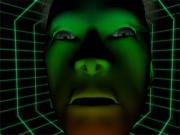Alright, one month since I got VW320. This is how it looks now:

I'm still using cheap,I say "disposable", keyboard and mouse, but looks like i'm gonna get original VW keyboard soon. Windows 2000 appeared to be a better OS than I expected. After installing Microsoft Services for Unix I have a normal shell in Windows, a better POSIX compability and even GCC. But I miss mediarecorder, videoin and videoout from Irix. HackTv and Qcap are crap: slow and buggy. Also I missed red mouse pointers, but this was not a problem - I manged to create my own cursor set for Windows. It doesn't exactly match X11 cursor set, but If someone needs it, grab it here:
(link removed)
About the performance. While the Cobalt chipset is a little bit faster than MXE of my Octane(measured with Viewperf 7.0), dual R12k 360MHz still
greatly
outperform dual P-III 500MHz. On some tasks like rendering in Blender or raytracing with C-Ray Octane is nearly two times faster. Rendering in Maya is about the same, but I suspect this is just a result of a better optimisation for x86, because once my 3D scene needs fluid or rigid body simulations Octane is faster again. Although, web serfing seems to be more comfortable in Windows. At least Firefox doesn't crash.
Games played:
Quake 3 - runs fine. FPS is a little bit higher than on my Octane.
Half-Life - runs fine, with a decent FPS, but not in fullscreen.
Serious Sam - slow, after 20-30 secs of gameplay the systems reboots. Overheating?
Age of Empires II - runs great. No wonder - it's a 2D game.
Return to Castle Wolfenstein - satisfying, FPS varies from low at outdoors locations to good at indoors. But all sounds are delayed by a second. Probably DirectX's fault?



































